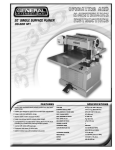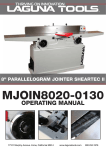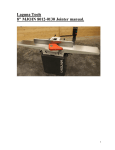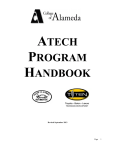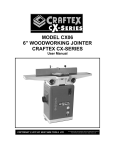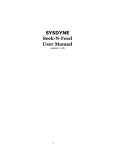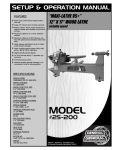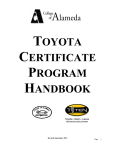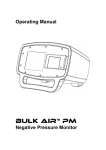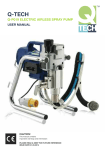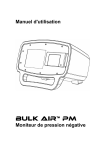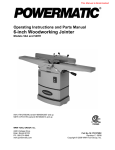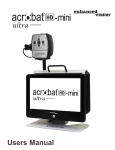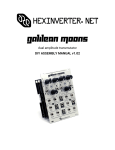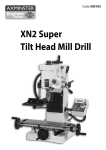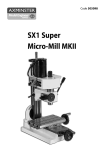Download Operator`s Manual
Transcript
6" Wedgebed Jointer ShearTec II MJOIN6100-0130 MJOIN6200-0130 OPERATING MANUAL 17101 Murphy Avenue. Irvine, California 92614 www.lagunatools.com 800.234.1976 Table of contents SAFETY INSTRUCTIONS ................................................................................................................... 2 RECEIVING T HE JOINTER ............................................................................................................... 4 INSTALLATION ..................................................................................................................................... 4 MOUNTING JOINTER TO STAND..................................................................................................... 5 CUTTERHEAD GUARD I NSTALLATION & REMOVAL ................................................................ 6 INSTALLING DUST CHUTE................................................................................................................ 6 GROUNDING INSTRUCTIONS .......................................................................................................... 7 SAFETY SWITCH ................................................................................................................................. 8 ADJUSTMENTS .................................................................................................................................... 8 INSTALLING NEW KNIVES ................................................................................................................ 9 STANDARD BLADES CUTTERHEAD............................................................................................... 9 SHEARTEC 2 CUTTERHEAD ...........................................................................................................11 CUTTERHEAD REMOVAL .................................................................................................................11 DEPTH OF CUT .................................................................................................................................. 12 JOINTING KNIVES ............................................................................................................................. 12 TABLE GIBS AND LEVELING .......................................................................................................... 13 FENCE ADJUSTMENTS: TILT ........................................................................................................ 13 BASIC OPERATIONS ........................................................................................................................ 15 PARTS DIAGRAMS ............................................................................................................................ 19 PARTS LIST ......................................................................................................................................... 22 1 SAFETY INSTRUCTIONS For Your Safety Read Instruction Manual Before Operating Jointer As with all machines, there is a certain amount of hazard involved with the use of this jointer. Use the machine with the respect and caution demanded where safety precautions are concerned. When normal safety precautions are overlooked or ignored, personal injury to the operator can result. Wear eye protection. Always keep cutter head and drive guards in place and in proper operating condition. Do not remove guard for rabbeting operations. Never make jointing , planning, or rabbeting cut deeper than 1/8 in. Always use hold-down/push blocks for jointing material narrower than 3 inches, or planning material thinner than 3inches. Never perform jointing. Planning, or rabbeting cuts (with jointers provided with a rabbeting guard) on pieces shorter than 8 inches (203 mm) in length. Keep guards in place and in working order. Remove adjusting keys and wrenches. Form habit of checking to see that keys and adjusting wrenches are removed from tool before turning it on . Keep work area clean. Cluttered areas and benches invite accidents. Don’t use in dangerous environment. Don’t use power tools in damp or wet locations, or expose them to rain. Keep work area well lighted. Keep children away. All visitors should be kept safe distance from work area. Make workshop kid proof with padlocks, master switches, or by removing starter keys. . Don’t force tool. It will do the job better and safer at the rate for which it was designed. Use right tool. Don’t force tool or attachment to do a job for which it was not designed. Use proper extension cord. Make sure your extension cord is in good condition. When using an extension cord, be sure to use one heavy enough to carry the current your product will draw. An undersized cord will cause a drop in line voltage resulting in loss of power and overheating Table (see Figure 9) shows the correct size to use depending on cord length and nameplate ampere rating. If in doubt, use the next heavier gage. The smaller the gage number, the heavier the cord. Wear proper apparel. Do not wear loose clothing, gloves, neckties, rings, bracelets, or other jewelry which may get caught in moving parts. Nonslip footwear is recommended. Wear protective hair covering to contain long hair. Always use safety glasses. Also use face or dust mask if cutting operation is dusty. Everyday eyeglasses only have impact resistant lenses, they are NOT safety glasses. Secure work. Use clamps or a vise to hold work when practical. It’s safer than using your hand and it frees both hands to operate tool. Don’t overreach. Keep proper footing and balance at all times. Maintain tools with care. Keep tools sharp and clean for best and safest performance. Follow instructions for lubricating and changing accessories. Disconnect tools before servicing; when changing accessories, such as blades, bits, cutters, and the like. Reduce the risk of unintentional starting. Make sure switch is in off position before plugging in. 2 Use recommended accessories. Consult the owner’s manual for recommended accessories. The use of improper accessories may cause risk of injury to persons. Never stand on tool. Serious injury could occur if the tool is tipped or if the cutting tool is unintentionally contacted. Check damaged parts. Before further use of the tools, a guard or other part that is damaged should be carefully checked to determine that it will operate properly and perform its intended function – check for alignment of moving parts, binding of moving parts, breakage of parts, mounting , and any other conditions that may affect its operation. A guard or other part that is damaged should be properly repaired or replaced. Direction of feed. Feed work into a blade or cutter against the direction of rotation of the blade or cutter only. Never leave tool running unattended. Turn power off. Don’t leave tool until it comes to a complete stop. Do not perform jointing operation on material shorter than 8 in , narrower than 3/4 in, or less than 1/4 in thick. Do not perform planing operation on material shorter than 8 in , narrower than 3/4 in, or wider than 6” in or thinner than 1/2 in. Maintain the proper relationships of infeed and outfeed table surfaces and cutter head knife path. Support the work piece adequately at all times during operation; mqintain control of the work at all times. Do not back the work toword the infeed table. Do not attempt to perform an abnormal or a little-used operation without study and the use of adequate holddown/push blocks, jigs, fixtures, stops and the like. Hand safety. It is good practice to move the hands in an alternate motion from back to front as the work continues through the cut. Never pass the hands directly over the cutter knife. As one hand approaches the knives remove it from the stock in an arc motion and place it back on the stock in a position beyond the cutterknife. Three inch rule. When working a piece of wood on the jointer, follow the 3 inch radius rule. The hands must never be closer than 3 inches to the cutter head. Health hazards. Some dust created by power sanding, sawing, grinding, drilling and other construction activities contains chemicals known to cause cancer, birth defects or other reproductive harm. Some examples of these chemicals are: * Lead from lead-based paint. * Crystalline silica from bricks and cement and other masonry products. * Arsenic and chromium from chemically-treated lumber. Your risk from these exposures varies, depending on how often you do this type of work. To reduce your exposure to these chemicals, work in a well-ventilated area, and work with approved safety equipment, such as those dust masks that are specifically designed to filter out microscopic particles. Familiarize yourself with the following safety notices used in this manual: ! CAUTION: (This means that if precautions are not heeded, it may result in minor or moderate injury and/or possible machine damage) ! ! WARNING: (This means that if precautions are not heeded, it could result in serious injury or possibly even death). 3 RECEIVING T HE JOINTER Upon delivery, open shipping containers and check that all parts are in good condition. Any damage should be reported to your distributor and shipping agent immediately. Before proceeding further, read your manual and familiarize yourself thoroughly with assembly, maintenance and safety procedures. Contents of box 1: 1 jointer stand 1 door 1 dust chute Contents of box 2: 1 jointer assembly 1 fence assembly 1 pulley cover 1 belt 1 cutterhead guard 2 hold-downs 1 hardware bag The contents of the hardware bag are drawn full scale in Figure 1. FIGURE 1 Moisten a soft cloth with kerosene and remove t he protective coating from all machined surfaces of the jointer. Do NOT use an abrasive p ad. Do not use gasoline, acetone or lacquer thinner, as this may damage painted surfaces. Although some users prefer a wax coating for the table surfaces, white talcum powder rubbed in vigorously once a week with a blackboard eraser will fill any casting pores and form a moisture barrier. Talcum powder will not stain wood or mar finishes. INSTALLATION FIGURE 2 Tools required 12mm and 14mm wrenches screwdriver Locate the jointer in an area that is level and provides a solid foundation. Make sure that any potential kick- back i s not i n line with aisles, doorways, w ash stations or other work areas. 4 MOUNTING JOINTER TO STAND 1. Position the jointer on the stand so that the pulley attached to the cutterhead on the jointer is directly above and on the same side as the motor pulley. 2. Use three lock bolts and spring washers to firmly fasten the jointer to the stand. The bolts are threaded up through the holes in the stand into the base of the jointer. See Figure 2. Use a wrench to tighten. INSTALLING B ELT FIGURE 3 To attach the belt to the cutterhead pulley and motor pulley, first reach into the dust chute with a wrench and loosen the four bolts holding the motor to the mount b racket. Align the pulleys u sing the slotted holes on the mounting bracket. Raise the motor as high as possible and mount the belt on to both pulleys. Allow the motor to drop and create tension on the belt. Pull down on the motor to achieve the de- sired belt tension (the correct belt tension is achieved when the belt can be deflected approximately one inch at the center belt span using light finger pressure as shown in Figure 3.) Snug tight the four bolts. Pulley Cover 1/4*1/2 Screw Flat washer FIGURE 4 INSTALLING PULLEY COVER The pulley cover is mounted with four 1/4-20 x 1/2 handle screws and four flat washers to the threaded holes in the base, as shown in Figure 4. INSTALLING FENCE TO BED Referring to Figure 5: 1. Take the lock handle (E), flat washer (F), and lock nut (G) from the carton. 2. Place the fence assembly (A) onto the table (B) Be sure the key stock (D) on the bed lines up with the channel (C) in the fence casting. 3. Place the flat washer (F) on hole(H); insert the lock handle (E) through the fence casting and the table casting. 4. Thread the lock nut (G) onto the lock handle (E). Make sure the tab on the nut faces up and engages the slot in the table casting. *Note: For rabbeting operations use hole (J). FIGURE 5 5 CUTTERHEAD GUARD I NSTALLATION & REMOVAL ! WARNING: Use the jointer guard for al l operations. 1. Disconnect jointer from power source. 2. Turn knob (A) counterclockwise to create tension on spring, and hold it there. See Figure 6 3. Insert guard post (B) down through hole in front of ledge. 4. Slightly turn knob (A), if necessary, until the guard seats itself, and the spring engages the slot at the end of the guard post. 5. Check the guard for proper tension. If guard does not spring back into place when pulled back from cutterhead, remove guard and adjust spring tension by repeating steps 1-3 until correct tension is achieved. NEVER run the jointer without the guard being in place and in perfect working order. FIGURE 6 INSTALLING DUST CHUTE Mount the dust chute to the pre-tapped holes in the side of the stand with four 1/4-20 x 1/2 handle screws and four flat washers. See Figure 7. FIGURE 7 6 must be reconnected for use on a different type of electric circuit, the reconnection should be made by qualified service personnel and after reconnection, the tool should comply with all local codes and ordinances. GROUNDING INSTRUCTIONS ! WARNING: If the machine does not come wired to run, the electricals and motor wiring must be done by a qualified electrician. The machine must be properly grounded to help avoid electrical shock and possible death. Follow the recommendations made by the National Electrical Code for grounding. EXTENSION CORDS Use proper extension cord. Make sure your extension cord is in good condition. When using an extension cord, be sure to use one heavy enough to carry the current your product will draw. An undersized cord will cause a drop in line voltage resulting in loss of power and overheating. Figure 9 shows the correct size to use depending on cord length and nameplate ampere rating. If in doubt, use the next heavier gauge. The smaller the gauge number, the heavier the cord. 1. All grounded, cord connected tools: In the event of a malfunction or breakdown, grounding provides a path of least resistance for electric current to reduce the risk of electric shock. This tool is equipped with an electric cord having an equipmentgrounding conductor and a grounding plug. The plug must be plugged into a matching outlet that is properly installed and grounded in accordance with all local codes and ordinances. Do not modify the plug provided - if it will not fit the outlet, have the proper outlet installed by a qualified electrician. Improper connection of the equipment-grounding conductor can result in a risk of electric shock. The conductor with insulation having an outer surface that is green, with or without yellow stripes, is the equipment-grounding conductor. If repair or replacement of the electric cord or plug is necessary, do not connect the equipment-grounding conductor to a live terminal. Check with a qualified electrician or service personnel if the grounding instructions are not completely understood, or if in doubt as to whether the tool is properly grounded. Use only 3-wire extension cords that have 3prong grounding plugs and 3-pole receptacles that accept the tool’s plug. Repair or replace damaged or worn cord immediately 2. Grounded, cord-connected tools intended for use on a supply circuit having a nominal rating less than 150 volts: This tool is intended for use on a circuit that has an outlet that looks like the one illustrated in Sketch A, Figure 8. The tool has a grounding plug that looks like the plug illustrated in Sketch A. A temporary adapter, which looks like the adapter illustrated in Sketches B and C in Figure 8, may be used to connect this plug to a 2-pole receptacle as shown in Sketch B if a properly grounded outlet is not available. The temporary adapter should be used only until a properly grounded outlet can be installed by a qualified electrician. The green-colored rigid ear, lug, and the like, extending from the adapter must be connected to a permanent ground such as a properly grounded outlet box. Note: In Canada, the use of a temporary adapter is not permitted by the Canadian Electrical Code 3. Grounded, cord-connected tools intended for use on a supply circuit having a nominal rating between 150-250 volts, inclusive: This tool is intended for use on a circuit that has an outlet that looks like the one illustrated in Sketch D Figure 8. The tool has a grounding plug that looks like the plug illustrated in Sketch D. Make sure the tool is connected to an outlet having the same configuration as the plug. No adapter is available or should be used with this tool. If the tool REWIRING MOTOR FOR 230 VOLTS When rewiring the supplied electric motor for 230 volts, be sure power cord is unplugged then change the connections as illustrated in the diagram in the motor wiring box. Always secure wire nuts with friction tape. A new plug will be required for 230 volts as illustrated in Figure 8, Sketch D. GROUNDING PIN FIGURE 8 Note: In Canada, the use of a temporary adapter is not permitted by the Canadian Electrical Code. Ampere Rating Ampere Volts 115/230 Total length of cord in feet 25' Rating Not More Than More Than 0 6 10 12 6 10 12 16 50' 100' 150' AWG 18 18 16 14 16 16 12 16 14 12 16 14 12 12 Not recommended FIGURE 9 Note: The reconnection shall be made by qualified service personnel. 7 SAFETY SWITCH The jointer is equipped with a push-button switch that will accept a safety padlock (not included). See Figure 10. To safeguard your machine from unauthorized operation and accidental starting by young children, the use of a padlock is required. ADJUSTMENTS FIGURE 10 Tools required 8mm, 10mm 12mm, and 19mm wrenches 3mm and 6mm hex wrenches G RAISING AND LOWERING TABLES Figures 11 and 12 D C To adjust infeed table: 1. Loosen the rear thumb screw (B), and the locking handle (C). FIGURE 11 2. Raise or lower the height adjustment handle (D) until the scale (G) reads approximately at the correct depth of cut. 3. Turn the locking handle (C) until it is snug, then fine-tune the adjustment with the height adjustment handle (D) by rotating it until the scale reads exact . (Clockwise raises the table, counterclockwise lowers the table.) NOTE: The fine adjustment handle has 1/16" travel per rotation. 4. B E When set, retighten screw (B). F To adjust outfeed table: 1. Loosen thumbscrew (E). 2. Turn handwheel (F) located on the underside of the outfeed table. 3. When set, retighten thumbscrew (E). FIGURE 12 WARNING: There is a Depth Stop Limited on the back side that must be released if cutting a depth greater than 1/8". If hand wheel seems jammed, please check and release the Depth Stop Limiter on the back side of the jointer. 8 INSTALLING NEW KNIVES STANDARD BLADES CUTTERHEAD Unplug or disconnect jointer from power source and lock out power. When installing new knives remove only one knife at a time. Clean the knife slot and install the new knife. Adjust and lock new knife in cutterhead assembly before proceeding to next knife. To remove the old knives, loosen gib locking bolts (A) with an 8mm wrench, and remove gib, knife, and jack screws, Figure 13. Using a hex wrench, turn jack screws (B) down one turn. Clean the jack screws, gib, knife slot, and knife thoroughly and replace jack screws. Sandwich knife and gib together and drop into knife slot. Be certain that the back of the knife is resting on the seat of the jack screw plug. Next, a shop scale should be placed flat on the end of the cutterhead. Slide the knife out until it is flush with the end of the shop scale. Set the knife locking gib 1/32 inch in from the end of the knife, Figure 14. ! FIGURE 13 WARNING: Set the knives no more than .015 inches above the body of the cutterhead to minimize the hazard of kickbackand severe personal injury. Snug the two outside gib locking screws. If you have a knife setting gauge, place it on the outfeed table and "0" the indicator as shown in Figure 15. Lift the gauge off the outfeed table to see how far below the bottom of the gauge the indicator travels. The indicator should read between .025 and .050 as shown in Figure 16. If the indicator reads outside of this range, loosen the set screw in the side of the gauge and adjust the indicator so that it will read within the range above. Zero the indicator as shown in Figure 15. Repeat this process until indicator reads within the .025 to .050 range. Always zero the indicator (as shown in Figure 15) before each use. FIGURE 14 FIGURE 15 9 Now place it on the outfeed table to the rear of the cutterhead with the flat indicator point over the cutterhead (Figure 17) Insert a hex wrench into the jack screw and rock the cutterhead back and forth. Watch the pointer on the knife-setting gauge. The pointer will begin moving to- ward "0". When the pointer reaches "0", it is parallel with the outfeed table. Move the gauge to the front of the cutterhead and repeat the above procedure. This adjusting process puts the knife into the knife slot with the tip parallel and flush with the outfeed table. Once the correct knife height has been estab- lished, secure the gib locking screws. Begin with the center screw (to prevent buckling or uneven knives). FIGURE 16 If a knife setting gauge is not available, use a standard shop scale. Stand the scale on its edge on the outfeed table; the scale should extend over the cutterhead. Using the above method, raise knife until it just touches t he scale at t he high point o f the cutterhead arc. FIGURE 17 OUTFEED TABLE AND KNIVES The outfeed table must be set exactly level with the knives at the highest point of their revolution. Knives must also be parallel to the outfeed table. To check alignment: ! è WARNING: Disconnect machine from power source before making alignments. 1. Place a steel straightedge on outfeed table and extend it over the cutterhead as shown in Figure 18. FIGURE 18 2. Rotate the cutterhead by hand. If a knife is too low or too high at either end, lightly loosen the two lock screws in the knife, as shown in Figure 18. Move the knife until it barely scrapes the straightedge, and tighten the lock screws securely. Makesure each knife does not extend more than .015 inches beyond the cutterhead. 3. For a final check, set the infeed table for no more than a 1/64" cut, turn on machine and run a piece of wood over the cutterhead for 6 to 8 inches. The stock should rest firmly on both tables with no space under the finished cut as shown in Figure 19. Remember, NEVER attempt to take off more than 1/64" in each pass when making outfeed table ad- justments. FIGURE 19 10 CUTTERHEAD REMOVAL SHEARTEC 2 CUTTERHEAD If removal of the cutterhead is necessary, do the following: WARNING: Knife inserts are dangerously sharp. Use extreme caution when inspecting, removing or replacing knife inserts. ! The knife inserts on the Jointer are four-sided. When dull, simply remove each insert, rotate it 90° for a fresh edge, and re-install it. No further adjustment is necessary. Use the two provided torx wrench to remove the knife insert screw. Use one of the torx wrenches to help hold the cutterhead in Position, and the other to remove the screw. See Figure 19A. It is advisable to rotate all inserts at the same time to maintain consistent cutting. However, if one or more knife inserts develops a nick, rotate only those inserts that are affected. Each knife insert has an etched reference mark so you can keep track of the rotations. WARNING: Disconnect jointer from power source. 1. Remove the entire fence assembly by releasing lock handle and removing hex nuts (see page 4) Lift the fence off the machine. 2. Loosen the bolts connecting the motor to the motor mount and remove the drive belt from cutter- head pulley (see page 4). 3. Lower both infeed and outfeed tables to expose the cutterhead. 4. Remove the two bolts and spring washers which secure the cutterhead to the base, as shown in Figure 19B IMPORTANT: When removing or rotating inserts, clean saw dust from the screw, the insert, and the cutterhead platform. Dust accumulation between these elements can prevent the insert from seating properly, and may affect the quality of the cut. 5. Remove the cutterhead assembly, with studs at- tached, by lifting cutterhead straight up from base. The belt pulley may be left on cutterhead to assist in raising the cutterhead. 6. Remove pulley and both bearing housings with attached studs from the cutterhead. Before installing each screw, lightly coat the screw threads with machine oil and wipe off any excess. Securely tighten each screw which holds the knife inserts before operating the jointer! NOTE: You may wish to keep on hand an extra cutterhead in order to maintain shop productivity. 7. When mounting new cutterhead to base, make sure the curved seats of the base are cleaned and free of dust and grease. Make sure all knife insert screws are tightened securely. Loose inserts can be propelled at high speed from a rotating cutterhead, causing injury. FIGURE 19B FIGURE 19A 11 DEPTH OF CUT Depth of cut is determined by the height of the infeed table relative to the high point of the knives on the cutterhead. When facing the width of a board (as opposed to the edge of a board), NEVER attempt to take off more than 1/64" with each pass. The depth of cut is indicated by the scale located on the front of the jointer base as shown in Figure 20. FIGURE 20 JOINTING KNIVES After extended use it will be necessary to sharpen the knives on the cutterhead assembly so that all three knives protrude exactly the same height above the cutterhead . To joint the knives: ! WARNING: Disconnect machine from power source. Use approved eye protection whenever sharpening blades. FIGURE 21 1. Remove the cutterhead guard 2. Place a metal straightedge across both tables as shown in Figure 21, and make sure both tables are set t o the exact height o f the high point o f the knives. 3. Clamp a block of wood across the infeed table as shown in Figure 22 in order to block the end of a fine India stone or oilstone during the jointing opera- tion. This helps to prevent kickback of the stone. 4. Turn machine on. 5. Keeping hands well clear of the cutterhead, place the stone i nto position a s shown in Figure 22, and slide the oilstone back and forth across both tables until the knives are lightly jointed. FIGURE 22 6. TURN MACHINE OFF and visually inspect each knife. If only the high knife has been touched, lower the OUTFEED table 0.003” and continue the sharpening process until all three knives have been touched by the stone. 7. Replace cutterhead guard. 12 TABLE GIBS AND LEVELING The table gibs on your machine are factory adjusted and may never require readjustment. Should any adjustment become necessary, do the following: 1. Lightly loosen the gib adjusting screws (A), Figure 23. By loosening the lock nuts first the set screws should be loose enough to move the table. 2. Support the end o f the table and a t the same time, raise it up slightly, (it is recommended that an- other person hold and support the table when per- forming these adjustments). Snug the gib screws. Any adjustment of the gibs is very minute, perhaps even 1,000th of an inch. If the gibs are too tight the adjustment handles will be difficult to turn. If the gibs ar e too loose the tables could sag. Keep checking the level of the tables with a straightedge until leveling is achieved. When tables are level, tighten the lock screws. A A FIGURE 23 FENCE ADJUSTMENTS: TILT Fence adjustments are made with the lock handles shown in Figure 24. To slide the fence f orward or back on the table, loosen lock handle (A), slide the fence to the desired position and tighten handle (A) to secure fence. C To tilt the fence forward: 1. Loosen locking bolt (B), Figure 24. 2. Place a machinist protractor or triangle on the table and against the fence. Adjust the fence to the desired angle and tighten locking bolt (B) to secure the fence. A To tilt the fence back: B 1. Loosen locking bolt (B), Figure 24. 2. Flip back the stop block (C). 3. Adjust the fence to the desired angle and tighten locking bolt (B) to secure fence. ! CAUTION: When the jointing operation is finished with the fence tilted back, do not forget to flip the pivot stop block back to its original position. FIGURE 24 NOTE: The handle (A, Figure 24) can be adjusted to a more convenient position by loosening the nuts on its opposite end, turning the handle to the proper position, and retightening the nuts. 13 B Fence Stop Adjustments Periodically check the 90° and 45° backward (135°) tilt accuracy of the fence with an angle measuring device, such as an adjustable square or machinist’s protractor. C E D F 90º Fence Adjustment Referring to Figure 24A: The 90º stop is controlled by the stop bolt (E) and the stop plate (C). 1. Set the infeed table to approximately the same height as the outfeed table. A FIGURE 24A 2. Move the fence by releasing lock handle (D) and pushing the fence assembly until it overlaps the tables (B). 3. Tighten lock handle (D). 4. Adjust the fence to a 90º angle by releasing lock handle (J) pulling up on the fence handle and tightening the lock handle (J). Note: The stop bolt (E) should be resting against the stop plate (C). A FIGURE 25 5. Place an angle measuring device on the table and against the fence to confirm a 90º setting (A, Fig. 25). FIGURE 25 6. If the fence is not square to the table, release the lock handle (J), loosen the hex nut (F), and turn the stop bolt (E) until the fence is square to the table. F FIGURE 25 A 7. Tighten the lock nut (F) to retain the setting. Tighten the lock handle (J). 45º Fence Backward Stop Adjustment Referring to Figure 26: E G C D The 45º fence backward stop (fence positioned away from the operator) is controlled by the stop bolt (E). B H J FIGURE 26 1. Loosen the lock handle (A). Move the stop plate (D) out of the way and position the fence at the 135º angle. Make sure the fence sits against the stop bolt. (E). 2. Tighten the lock handle (A) 3. Place an angle measuring device on the table and against the fence to confirm a 135º setting (A Fig.27). A 4. To adjust, loosen the lock nut (F), turn the stop bolt (E) until a 135º angle is obtained. 5. Tighten the lock nut (F). FIGURE 27 14 two handed push block BASIC OPERATIONS Before m aking any c uts on t he s tock, m ake a f ew practice cuts by r aising t he i nfeed t able to “ 0" a nd with the power disconnected. In this manner you will acquaint yourself with the feel of jointer operations. SURFACING Adjust depth of cut. It is better to make cuts of approximately 1/64 inch. This will enable you to hav e better control over the material being surfaced. Make several passes if necessary to obtain proper stock removal. Never surface pieces shorter than 12 inches or thinner than 3/8 inch without the use of a special work holding fixture. Never surface pieces thinner than 3 inches without the use of a push block. On stock 8" to 12" long use a single two-handed push block (Fig. 27a). On stock longer than 12 inches use two push blocks ( Fig. 27b). With narrow stock use the type push block shown in Fig. 27c. When surfacing short stock over 4 inches wide, use two (2) push blocks to guide material over cutterhead (Fig. 27d). FIGURE 27a two push blocks for stock longer than 12 inches L-shaped push block for narrow stock FIGURE 27b two push blocks with dowels for short stock over 4 inches wide FIGURE 27c FIGURE 27d 15 SURFACING: L ONG BOARDS The use of push blocks w ill help to i nsure against hands coming in contact with cutterhead in the event of a kickback and as trailing end of board passes over cutterhead. When surfacing l ong s tock, p lace push block near the front of piece and start feeding wood with the right hand until guard has opened and cut is started (Fig. 28a). Place second push block near the rear of infeed table and continue feeding stock using the hand over hand method (Fig. 28b). Before the left hand is in the 3 inch area of the cutterhead move it over to the outfeed side (Fig. 28c). As soon as possible follow with the right hand over to the outfeed side and continue through with cut (Fig. 28d). Begin by feeding stock with right hand and apply pres- sure to front of stock with push block. When the stock is longer than twice the length of the infeed and outfeed tables, another helper or support table must be used to support the stock. left hand pushes down toward fence as right hand starts feed FIGURE 28a near cutter, feed hand over hand FIGURE 28b left hand is moved to outfeed side On outfeed Side both hands pull stock through FIGURE 28c FIGURE 28d 16 move fence forward to expose only amount of cutterhead required JOINTING (or EDGING) Never edge a board that is less than 3 inches wide, less than 1 /4 inch thick, or 12 inches long, w ithout using a push block. è ! CAUTION: When workpiece is twice the l ength of the jointer infeed or outfeed table use an infeed or outfeed support . Begin by feeding stock with right hand and apply pressure to front of stock with push block. When edging, make cuts of approximately 1/16 inch for hardwood and 1/8 inch for softwood. When edging wood wider than 3 inches lap the fingers over the top of the wood, extending them back over the fence such that they will act as a stop for the hands in the event of a kickback. Keep stock against the fence (Fig. 29). FIGURE 29 BEVELING When beveling never make cut deeper than 1/16 inch. Make certain material being beveled is over 12 inches long, more than 1/4 inch thick and 1 inch wide. Set fence to desired angle. ! è CAUTION: Although fence may be tilted in FIGURE 30a or out for bevel cut, Sunhill Machinery recommends for safety reasons the fence b e tilted in, if possible, making a cradled cut (Fig. 30a). For wood wider than 3 inches, hold with fingers close together near the top of the stock, lapping over the board and extending over the fence. When beveling material less than 3 inches wide, use beveled push blocks and apply pressure toward the fence. Keep fingers near top of push block (Fig. 30b). When beveling short material use one bevel hold down and apply pressure toward the fence. Keep thumb above the ledge on hold down block (Fig. 30c). FIGURE 30b CROSS GRAIN NOTE: When beveling around four edges of a workpiece, make cross grain cuts first. This will help clean up any chipping or splintering when beveling the end grain. For long boards, follow the same hand-over-hand pro- cedure used for surfacing long boards, (pg. 15). FIGURE 30c 17 SKEWING ( SHEAR CUTTING) When edging or facing burl or birds-eye maple, it is not unusual to deface or mar the surface being finished. This i s caused b y the cutterhead b lades a t times cutting against the grain. In order to prevent the defacing or marring of this type wood, it is necessary to skew, or angle finish, the material being worked. See Figure 31. 1. Release the fence locking handle and remove the two hex nuts and flat washer holding the fence to the fence support (see page 4). Remove the fence. 2. Remove the key from the fence slide base. FIGURE 31 3. Replace the fence assembly at the desired angle across the cutterhead. Secure the fence to the sup- port with the two hex nuts and flat washer, then tighten the fence locking handle. PUSH B LOCKS Push blocks are simple, yet necessary tools to assist the operator especially when jointing thin or short stock. Illustrated in Figure 32 are three types of push blocks commonly used in jointing. Push blocks may be obtained commercially or easily constructed. NOTE: The Jointer is supplied with two push block for feeding stock. FIGURE 32 18 PARTS DIAGRAMS 19 20 21 PARTS LIST Key Part No. Descriptions Q'ty 1 360034-901 KNOB FENCE 2 2 006002-091 FLAT WASHER 1 3 380209-901 T-NUT 1 4 051131-000 HOLDER FENCE 1 5 290003-901 BOLT SHOULDER 1 6 170047-901 PLATE STOP 1 7 006002-097 FLAT WASHER 13.5*40*3.0t 2 8 011002-103 SPRING PIN 4*12 2 9 380080-000 KEY 1 10 011002-105 SPRING PIN 4*20 1 11 050373-000 CLAMP 12 006001-069 FLAT WASHER 10*20*3.0t 1 13 006001-082 FLAT WASHER 10.5*28*3.0t 1 14 003105-103 CAP SCREW 3/8"-16NC*1-1/2" 2 15 003602-102 FLAT HD SOC. SCREW 5/16"-18NC*1-5/8" 1 16 050031-000 FENCE 1 17 360676-901 STUD PIVOT 2 18 009010-200 HEX. NUT 19 290004-901 BOLT SHOULDER 10*6 1 20 130007-903 NUT PIVOT 1 21 130008-903 NUT HANDLE 1 22 170598-901 STOP FENCE 1 23 009008-200 HEX. NUT 7/16"-14NC(17.4B*9.52H) 1 24 009005-200 HEX. NUT 5/16"-18NC(12.7B*6.75H) 2 25 003003-208 HEX. SCREW 5/16"-18NC*1-3/4" 1 26 360035-902 SHAFT LOCK 1 27 130009-903 BLOCK ASM DEPTH 1 28 130055-903 SLEEVE FENCE 1 29 009012-200 HEX. NUT 30 360038-901 HANDLE SHAFT 1 31 250034-615 KNOB FENCE TILT 1 32 170048-901 BRACKET FENCE 1 33 006001-032 FLAT WASHER 6.6*13*1.0t 3 34 003301-101 PAN HD SCREW 1/4"-20NC*1/2" 3 1 1/2"-20NF(19.05B*11.11H) 5/8"-18NF 22 2 2 Key Part No. Descriptions Q'ty 35 003003-205 HEX. SCREW 5/16"-18NC*1" 36 050032-000 TILT PLATE 1 37 230015-901 STUD PIVOT 4 38 009022-100 HEX. NUT 3/8"-16NC 4 39 922884-000 TABLE ASS'Y CSA/UL 1 .1 003104-103 CAP SCREW 5/16"-18NC*3/4" 1 .2 003104-107 CAP SCREW 5/16"-18NC*2" 2 .3 003201-102 SET SCREW 1/4"-20NC*3/8" 3 .4 009004-100 HEX. NUT 1/4"-20NC 5 .5 006305-100 LOCK WASHER 8.2*15.4 2 .6 006709-100 WAVE WASHER WW12A 1 .7 010203-000 RETAINING RING ETW-6 3 .8 010208-000 RETAINING RING ETW-12 2 .9 230013-901 SET SCREW 5 .10 380066-000 GIB 2 .11 050734-000 TABLE OUTFEED 1 .12 190011-901 COLLAR 1 .13 006004-086 FLAT WASHER .14 130011-903 CLAMP 1 .15 360037-000 SCREW ELEVATION 1 .16 051123-000 TABLE INFEED 1 .17 050083-000 BASE 1 .18 360056-901 SHAFT 1 .19 170101-901 FIXED PLATE 1 .20 170102-901 TILT PLATE 1 .21 290035-901 STUD PIVOT 1 .22 360058-901 GUARD POST 1 .23 130016-000 ADJUST PLATE 1 40 230053-000 SCREW WING 2 41 003202-103 SET SCREW 5/16"-18NC*3/4" 2 42 009005-100 HEX. NUT 5/16"-18NC 3 43 130015-903 FIXED PLATE 44 003104-103 CAP SCREW 45 230027-901 BOLT 1 46 571984-000 POINTER 1 48 250035-629 PUSH BLOCK 2 11.5*16*0.5t 1 1 1 5/16"-18NC*3/4" 23 5 Key Part No. Descriptions Q'ty 49 920201-000 HANDLE ASS'Y 1 50 920165-000 HANDWHEEL 1 51 050065-901 BLOCK ASM DEPTH 1 52 360033-901 PLUNGER 1 53 280010-000 SPRING 1 54 380085-901 HOUSING PLUNGER 1 55 230156-615 KNOB PLUNGER 56 230016-000 LOCK HANDLE 60 006307-100 LOCK WASHER 10.2*18.5 5 61 003006-301 HEX. SCREW 3 STANDARD BLADES CUTTERHEAD ASS'Y 3/8"-24NF*89mm 2 .1 000701-103 FLAT HD SOC. SCREW M5*0.8P*12 .2 220009-000 CUTTER HEAD 1 .3 280052-000 SPRING 6 .4 003201-102 SET SCREW .5 050018-901 BEARING HOUSING 1 .6 920153-000 KNIFE LOCK BAR ASS'Y 3 .7 210006-000 KNIFE 3 .8 030206-000 BALL BEARING 6202-2NSE 1 .9 012003-009 KEY 5*5*25 1 .10 030207-000 BALL BEARING 6203-2NSE 1 .11 050019-901 BEARING HOUSING 1 .12 050020-901 PULLEY 1 SHEARTEC 2 CUTTERHEAD ASS'Y 1 .1 922856-000 SHEARTEC 2 CUTTERHEAD 1 .2 850587-000 HARDWARE BAGE FOR SHEARTEC 2 1 65-1 921738-000 65-2 922855-000 22*1/4"-20NC 1 1 1 1/4"-20NC*3/8" 6 2 038201-702 TORX SCREW #10-32UNF*12.5 10 040703-000 TORX WRENCH T-25 2 922844-000 KNIFE INSERT ASSY 15*15*2.5t*5PCS 1 .3 050018-901 BEARING HOUSING 1 .4 030206-000 BALL BEARING 6202-2NSE 1 .5 030207-000 BALL BEARING 6203-2NSE 1 .6 050019-901 BEARING HOUSING 1 .7 050020-901 PULLEY 1 .8 012003-009 KEY 5*5*25 1 .9 003201-102 SET SCREW 1/4"-20NC*3/8" 2 24 Key Part No. Descriptions Q'ty 70 002301-201 RIVET 71 920155-000 CUTTERHEAD GUARD ASS'Y 1 72 170045-901 RETAINER 1 73 280009-000 SPRING 1 74 110024-000 KNOB 1 75 110004-000 RETAINING KNOB 1 76 003305-206 PAN HD SCREW KNIFE SETTING GAUGE ASS'Y FOR STANDARD CUTTERHEAD 5/32"-32NC*5/8" 87 040003-000 HEX. WRENCH 3mm 1 88 040201-000 WRENCH BOX 8*10 1 89 040204-000 WRENCH BOX 12*14 1 95 170095-000 BELT GUARD 96 006002-032 FLAT WASHER 6.6*13*1.0t 12 97 003301-201 PAN HD SCREW 1/4"-20NC*1/2" 12 98 250036-615 DUST CHUTE 1 100 937575-000 ON-OFF SWITCH 1 .1 841007-001 ON-OFF SWITCH 1 .2 250479-615 BOX SWITCH 1 .3 170694-902 PLATE SWITCH BEZEL 1 .4 000302-209 PAN HD SCREW .5 380332-905 PIN .6 000302-203 PAN HD SCREW M4*0.7P*10 2 .7 008002-200 HEX. NUT M4*0.7P 2 .8 006501-100 LOCKWASHER 4.3*8.5 2 101 453011-013 POWER CORD SJT 14AWG*3C*2400mm 1 104 230010-000 STUD PIVOT 1 105 110005-000 DOOR LATCH 1 106 009006-200 HEX. NUT 3/8"-16NC 1 107 003302-202 PAN HD SCREW 1/8"-40NC*3/8" 4 108 006002-001 FLAT WASHER 4.3*10*1.0t 4 111 922857-000 STAND ASS'Y 1 .1 172993-000 STAND 1 .2 922370-000 COVER ASS'Y 1 79 920206-000 2*5 6 3 1 1 M4*0.7P*25 2 1 112 020004-000 STRAIN RELIEF SB8R-1 1 116 006305-100 LOCK WASHER 8.2*15.4 8 117 006002-056 FLAT WASHER 8.5*23*2.0t 8 25 Key Part No. 118 900758-000 Descriptions Q'ty MOTOR ASS'Y 1.5HP.1PH 1 .1 603067-000 MOTOR 1.5HP*1PH 1 .2 012003-010 KEY 5*5*30 1 .3 050021-901 MOTOR PULLEY .4 003201-102 SET SCREW 1/4"-20NC*3/8" 2 .5 021316-000 STRAIN RELIEF MG16A-10B-ST 1 .6 473003-006 MOTOR CORD SJT14AWG*3C*750mm 1 119 003003-203 HEX. SCREW 5/16"-18NC*3/4" 4 120 014102-000 V-BELT A36 1 121 006307-100 LOCK WASHER 10.2*18.5 3 122 004902-101 SCREW HEX SER FI 3/8-16*3/4 3/8"-16NC 3 123 009005-200 HEX. NUT 5/16"-18NC 1 137 172317-902 COVER 138 009102-200 HEX. NUT 3/8"-16NC 4 139 004001-101 LOCK KONB 5/16"-18NC*3/4" 2 140 250400-000 WHEEL 141 003005-206 HEX. SCREW 3/8"-16NC*2-1/2" 4 142 003303-105 PAN HD SCREW 3/16"-24NC*3/8" 5 143 011003-207 SPRING PIN 5*30 1 148 173015-902 PLATE 149 040004-000 HEX. WRENCH 1 2 4 1 4mm 1 2014/06 26



























